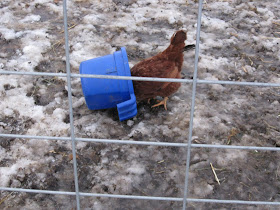Those of you who have followed along on this crazy venture since the start will remember that I set a goal for myself and my family of sourcing 50% of our eat-at-home food from within the county. Well, it's been a full year, and so I'd like to report on our (moderate) success and set some new goals for the coming year.
First, I'll just be blunt and say we didn't do it. Probably not even very close. There are many foods that my family simply won't give up, and cereal, rice, pasta, and bananas are among them. Coffee, chocolate, and orange juice. Really, I didn't try very hard to source foods that we eat all the time but which I'm pretty sure aren't grown in the county, like wheat, dry beans, and so forth. I just assumed they weren't available, period. However, I've just finished reading "Plenty," a book about a couple of fairly extreme fanatics who ate 99% locally (defined as produced within 100 miles) for a year, based in Vancouver B.C., which is only a few miles from me. They found wheat, eventually, and all sorts of products one would not expect. They put a lot of effort into it. I'm frankly not prepared to put that much time into sourcing ingredients, but I guess I can up it to a couple of hours. I guess I can ask at the Co-op. "Hey, is anybody growing lentils around here?" That's not too hard, is it?
On to the success stories: for seven months of the year, I didn't buy a single gallon of milk, nor an egg, nor any pork product. When I did buy milk, I could buy it from a local farm. I bought only about a third of my usual amount of cheese, because I was making lots of it. Ditto yogurt. I haven't bought beef for a few months now, since whenever it was that we got our quarter-steer. And for pretty much the entire growing season, say, May to the end of October, the majority of our produce needs were met by the trade network. Yes, yes, we ate more kale than we cared to, more beets and more pumpkins, but we ate well. I won't say I didn't buy produce, I had to keep buying onions and garlic, and we never did give up lemons. But I bought a lot of it from the local farmer's market, and some of it we grew ourselves (okay, just radishes, salad greens, herbs, and tomatoes. I never said I was a great gardener.)
I still have several quart sized ziploc bags of frozen local strawberries we picked ourselves back in June, and we ate the last blueberries yesterday (sigh). There are twelve frozen ears of local corn. About a dozen nectarines - well, wait, they weren't truly local, they came from Yakima. And let's not forget, the cabinet which is still stuffed with home canned goods - pickles, jams and cajeta. I'd better start trying to incorporate some of that into our diet or it will still be around come next harvest-time.
So what can we do better next year? I'd like to expand the trade network. Unfortunately, my garden-lady friend found a new source for eggs while my hens were not laying, so I'll have to trade her something else. Goat's milk yogurt? Chevre? She said she'd be interested in a kid (one of the goat's, not one of mine) but I still don't know if any are on the way. That's going to be the hardest part of next year's local eating - accepting that we have to eat the baby goats. I hope I can do it. I can find a new gardener to trade with, and I'd better! because at the end of January I'm already getting 5 eggs a day, and I have the potential for a dozen a day in a couple of months here.
The pig will be meat soon, and he and the rest of the steer ought to last us for several months. Meat and dairy products are a cinch; it's finding more local products, expanding into the realm of dry goods, and finding more appetizing ways to preserve the harvest that will be the challenge. I think I'll set the same goal again: 50%. But this time, I'll take it more seriously.










